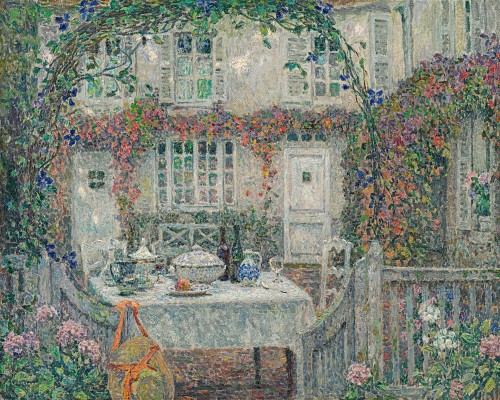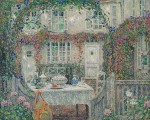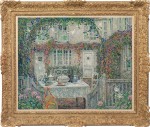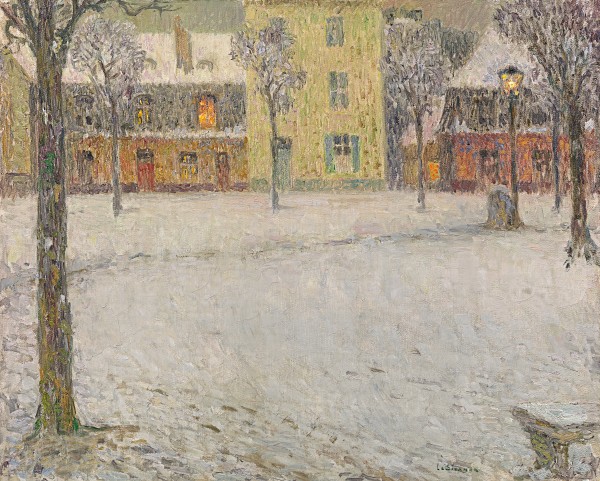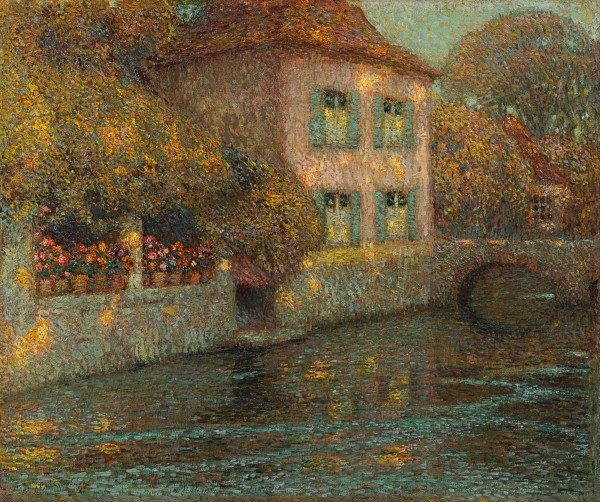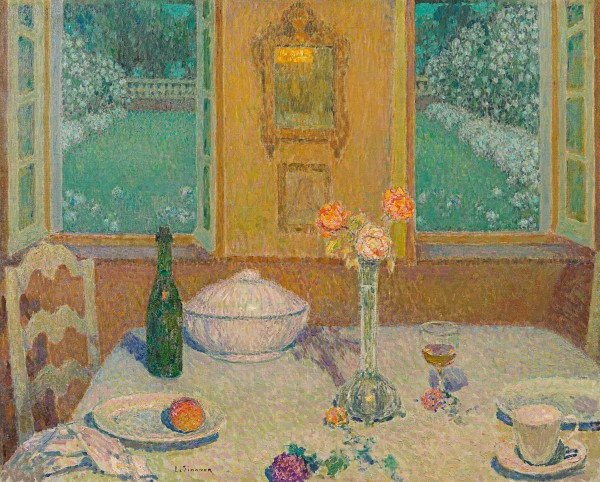Henri Le Sidaner
La table, automne, Gerberoy
Oil on canvas: 26 x 32.2 (in) / 66 x 81.9 (cm)
Signed lower left: Le Sidaner
This artwork is for sale.
Please contact us on: +44 (0)20 7493 3939.
Email us
HENRI LE SIDANER
Port-Louis 1862 - 1939 Versailles
Ref: CA 223
La table, automne, Gerberoy
Signed lower left: Le Sidaner
Oil on canvas: 26 x 32 ¼ in / 66 x 81.9 cm
Frame size: 34 ½ x 41 in / 87.6 x 104.1 cm
In an antique Louis XIV carved and gilded frame
Painted in September 1920
Provenance:
Galeries Georges Petit, Paris, no.5145 and 10566, acquired from the artist in January 1921 for FFr.2,400 Gaby Salomon, Buenos Aires Geo Davey, Paris Arthur Tooth & Sons, London
Mrs Nora Prince-Littler, London Christie’s London, 28th June 1977, lot 1; where acquired by Richard Green, London; private collection, USA, purchased from the above
Sotheby’s New York, 8th November 2006, lot 221;
Richard Green, London;
private collection, UK
Exhibited:
Pittsburgh, Carnegie Institute, International Exhibition, Salle Le Sidaner, April 1921, no.190
Paris, Musée Galliera, Rétrospective Henri Le Sidaner, April 1948, no.19 London, Roland Browse and Delbanco, Le Sidaner, February-March 1964, no. 57 London, Royal Academy, Post Impressionism, December 1979-March 1980, no.115, illus. Paris, Musée Marmottan, Henri Le Sidaner, May-July 1989, no.33, illus. pp.66, 101
Literature:
Yann Farinaux-Le Sidaner, Le Sidaner, l’Oeuvre peint et gravé, Paris 1989, p.170, no.427, illus.
Josefina R Aldecoa, La Enredadera, 2002, colour detail illus. on the cover
Certificate of authentication from Yann Farinaux-Le Sidaner, ref. no.LS 595
In 1901 Henri Le Sidaner visited Gerberoy, about six miles north-west of Beauvais in Picardy, in search of a house round which he could develop a garden. The area had been recommended to him by Rodin. Le Sidaner was enchanted by the ‘old sleepy town, steeped in history and gentle nostalgia’[1], where William the Conqueror had fought his unruly son and which had been besieged in the Hundred Years’ War and the sixteenth century Wars of Religion. Le Sidaner rented a small cottage which in 1910 he bought and began to enlarge, adding a garden of terraces, Italianate balustrades and pavilions, overlooking half-timbered houses, cobbled streets and the rolling countryside beyond.
The house was bitterly cold and Le Sidaner spent only one winter there, retreating otherwise to the comforts of Versailles, the South of France or elegant European cities such as Venice and London. In the summers Gerberoy was his paradise and the inspiration for many paintings depicting the house and its environs. It became as important to him as Giverny to Monet or Marquayrol to Henri Martin.
The theme of a table set for a meal in the courtyard of the house at Gerberoy was one that Le Sidaner revisited many times. This painting is a particularly successful example, with its harmonious interweaving of colours and textures. Underpinning the composition are many tonal variations on white, formed from a mosaic of associated colours: pale grey, lilac, eau-de-nil. It gives a living surface to the sun-dappled, white house, the snowy tablecloth and the shiny ceramics of the tureens and plates of the dinner service. Over this white foundation, Le Sidaner trails the intense colours of the Virginia creeper which covers the house, composed from dabs of red, orange, yellow, purple and emerald green. The entrance to the courtyard is framed by an arch covered with a brilliant, cobalt blue clematis. In the foreground, pink hydrangeas and the orange ribbon of an abandoned hat add other layers of colour in front of the white table and picket fence. Le Sidaner uses rich, broken impasto and colour both to construct a realistic, Post-Impressionist sense of space and to revel in the sheer enjoyment of paint.
Figures rarely appear in Le Sidaner’s mature work. A delightful human presence and domestic harmony is implied by the food on the table and the abandoned hat, as if the actors have left the stage only temporarily. The poet and art critic Camille Mauclair wrote of Le Sidaner: ‘He considered that the silent harmony of things is enough to evoke the presence of those who live among them. Indeed, such presences are felt throughout his works. Deserted they may be but never empty’[2].
The table in the sun in the garden, Gerberoy.
Musée des Beaux-Arts, Nantes.
HENRI LE SIDANER
Port-Louis 1862 - 1939 Versailles
Henri Le Sidaner was born in Port Louis, Mauritius in 1862, the son of a shipbroker of Breton descent. At the age of ten his family moved to Dunkirk and in 1880, after the death of his father, to Paris. Le Sidaner entered the studio of Alexandre Cabanel at the Ecole des Beaux-Arts in 1884, but was more inspired by Manet than by his master’s dry academicism.
In 1889 he moved to Etaples, where he met the painters Eugène Chigot and Henri Duhem, who were to remain lifelong friends. Le Sidaner made plein-air paintings of Breton peasants and fishermen in a subdued palette.
In 1892 a grant allowed him to paint in Florence, Venice and Katwijk in Holland. In 1894 he settled in Paris, transferring his allegiance from the Salon to the more avant-garde Société Nationale des Beaux-Arts. In this period Le Sidaner produced paintings such as the 1896 Morning (Musée de Dunkerque) and Twilight (private collection), which combine elements of Impressionist technique with Symbolist themes. That year he signed a contract with the Mancini Gallery.
In 1898 Le Sidaner turned decisively towards the highly individual style, building on the innovations of Impressionism, that would characterise his work for the rest of his life. In 1898 he went to Bruges with his lover Camille; their son Louis was born in Paris in October, although the couple was based in Bruges for another year. In 1899 they returned to Paris and Le Sidaner became one of the group of artists represented by Galeries Georges Petit, which would give him financial stability and remain his dealer until 1930.
Le Sidaner, keen to buy a country house around which he could develop a garden, was advised by Rodin to visit the terrain near Beauvais. In 1901 he rented a cottage in the picturesque town of Gerberoy (Seine et Oise). He bought it in 1904 and in 1910 greatly enlarged the house, creating a paradisiacal garden which provided the inspiration for many of his later paintings. Le Sidaner developed a poetic style of Post-Impressionism which explores the qualities of light and objects through harmonies and counterpoint of subtle tones. After 1900 he rarely included figures in his paintings, implying human presence through his interest in depicting a community of ancient houses, or a table set for tea. Le Sidaner’s works, with their evocation of mood and emotional engagement with landscape, have affinities with the music of ‘Impressionist’ composers such as Claude Debussy.
Le Sidaner travelled in search of new motifs, wintering in Venice or London to escape the freezing cold of Gerberoy. From 1914 his family was based at a comfortable house in Versailles and summered in Gerberoy. From around 1920 his paintings employ a lighter palette and sparer, more dreamlike compositions. He was awarded the Légion d’Honneur in 1913 and the First Prize at the 1925 Pittsburgh International. Henri Le Sidaner died in Paris in 1939.
[1] Farinaux-Le Sidaner op. cit., p.14.
[2] Henri Le Sidaner, Paris 1928, p.12.

